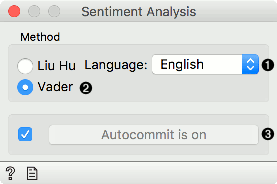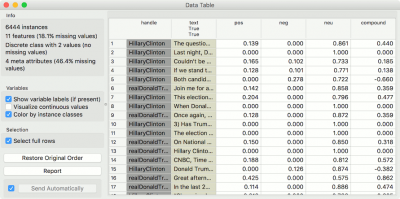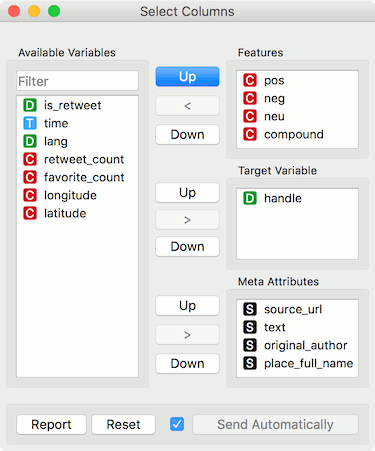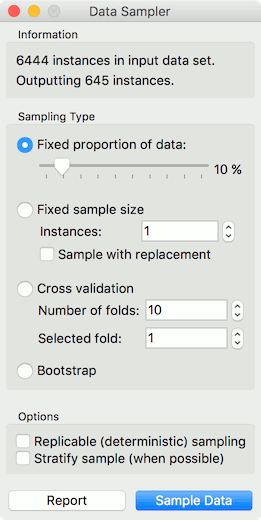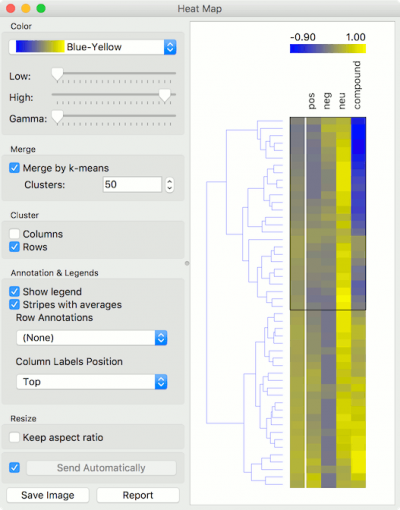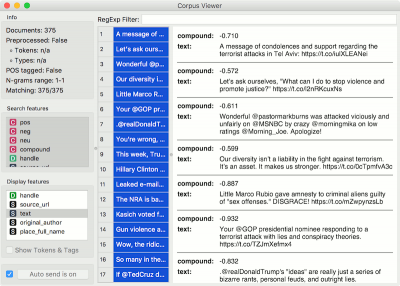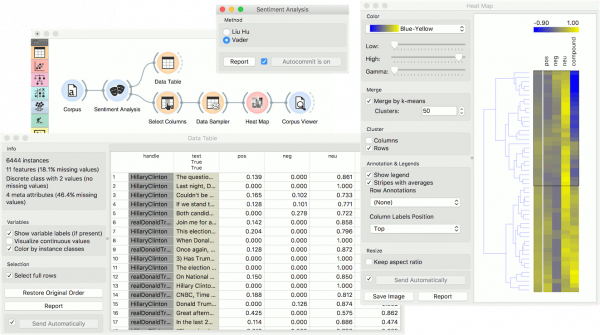Difference between revisions of "Orange: Sentiment Analysis"
Onnowpurbo (talk | contribs) |
Onnowpurbo (talk | contribs) (→Contoh) |
||
| (3 intermediate revisions by the same user not shown) | |||
| Line 2: | Line 2: | ||
| + | Widget Sentiment Analysis akan memprediksi sentiment dari text. | ||
| − | + | ==Input== | |
| − | + | Corpus: A collection of documents. | |
| − | + | ==Output== | |
| − | + | Corpus: A corpus with information on the sentiment of each document. | |
| − | + | Widget Sentiment Analysis memprediksi sentiment untuk setiap dokumen di corpus. Widget Sentiment Analysis menggunakan modul sentimen Liu Hu dan Vader dari NLTK. Kedua-nya adalah lexicon-based. Untuk Liu Hu, kita dapat memilih versi English atau Slovenian. | |
| − | + | [[File:SentimentAnalysis-stamped.png|center|400px|thumb]] | |
| − | + | * Method: | |
| − | + | ** Liu Hu: lexicon-based sentiment analysis (supports English and Slovenian) | |
| − | + | ** Vader: lexicon- and rule-based sentiment analysis | |
| − | + | * Produce a report. | |
| − | + | * If Auto commit is on, sentiment-tagged corpus is communicated automatically. Alternatively press Commit. | |
| − | |||
| − | |||
==Contoh== | ==Contoh== | ||
| − | Sentiment Analysis | + | Widget Sentiment Analysis dapat digunakan untuk membangun feature tambahan dengan prediksi sentimen dari corpus. Untuk mencoba ini, kita load Election-2016-tweets.tab menggunakan widget Corpus. Kemudian sambungkan widget Corpus ke widget Sentiment Analysis. Widget Sentiment Analysis akan menambahkan 4 feature baru dari Vader method: positive score, negative score, neutral score dan compound (combined score). |
| − | |||
| − | |||
| − | + | Kita dapat amati feature baru ini di widget Data Table, dimana kita simpan compound sebagai score. Compound merepresentasikan total sentiment dari tweet, dimana -1 adalah paling negatif dan 1 paling positif.. | |
| − | + | [[File:Sentiment-DataTable.png|center|400px|thumb]] | |
| − | + | Sebelum melakukan visualisasi, beberapa feature yang tidak kita inginkan dapat dibuang menggunakan widget Select Columns. | |
| − | + | [[File:Sentiment-SelectColumns.png|center|400px|thumb]] | |
| − | + | Sehingga corpus kita lebih kecil, sehingga lebih mudah memvisualisasikan. Kirimkan dapat ke widget Data Sampler dan simpan hanya 10% random tweet saja. | |
| − | + | [[File:Sentiment-DataSampler.png|center|400px|thumb]] | |
| − | + | Selanjutkan, kirim corpus yang sudah di filter ke widget Heat Map. Gunakan Merge by k-means untuk menggabungkan tweet dengan polaritas yang sama dalam satu kalimat. Kemudian gunakan Cluster by rows untuk membuat sebuah clustered visualization dimana tweet yang sama di kumpulkan menjadi satu. Klik pada sebuah cluster untuk memilih sebuah group dari tweet - misalnya, kita memilih negatif cluster. | |
| − | + | [[File:Sentiment-HeatMap.png|center|400px|thumb]] | |
| − | + | Untuk mengamati subnet yang di pilih, kirim tweet tersebut ke widget Corpus Viewer. | |
| + | [[File:Sentiment-CorpusViewer.png|center|400px|thumb]] | ||
| − | + | Keseluruhan workflow dapat dilihat di bawah ini. | |
| + | [[File:Sentiment-workflow.png|center|600px|thumb]] | ||
==Referensi== | ==Referensi== | ||
Latest revision as of 18:06, 11 April 2020
Sumber: https://orange3-text.readthedocs.io/en/latest/widgets/sentimentanalysis.html
Widget Sentiment Analysis akan memprediksi sentiment dari text.
Input
Corpus: A collection of documents.
Output
Corpus: A corpus with information on the sentiment of each document.
Widget Sentiment Analysis memprediksi sentiment untuk setiap dokumen di corpus. Widget Sentiment Analysis menggunakan modul sentimen Liu Hu dan Vader dari NLTK. Kedua-nya adalah lexicon-based. Untuk Liu Hu, kita dapat memilih versi English atau Slovenian.
- Method:
- Liu Hu: lexicon-based sentiment analysis (supports English and Slovenian)
- Vader: lexicon- and rule-based sentiment analysis
- Produce a report.
- If Auto commit is on, sentiment-tagged corpus is communicated automatically. Alternatively press Commit.
Contoh
Widget Sentiment Analysis dapat digunakan untuk membangun feature tambahan dengan prediksi sentimen dari corpus. Untuk mencoba ini, kita load Election-2016-tweets.tab menggunakan widget Corpus. Kemudian sambungkan widget Corpus ke widget Sentiment Analysis. Widget Sentiment Analysis akan menambahkan 4 feature baru dari Vader method: positive score, negative score, neutral score dan compound (combined score).
Kita dapat amati feature baru ini di widget Data Table, dimana kita simpan compound sebagai score. Compound merepresentasikan total sentiment dari tweet, dimana -1 adalah paling negatif dan 1 paling positif..
Sebelum melakukan visualisasi, beberapa feature yang tidak kita inginkan dapat dibuang menggunakan widget Select Columns.
Sehingga corpus kita lebih kecil, sehingga lebih mudah memvisualisasikan. Kirimkan dapat ke widget Data Sampler dan simpan hanya 10% random tweet saja.
Selanjutkan, kirim corpus yang sudah di filter ke widget Heat Map. Gunakan Merge by k-means untuk menggabungkan tweet dengan polaritas yang sama dalam satu kalimat. Kemudian gunakan Cluster by rows untuk membuat sebuah clustered visualization dimana tweet yang sama di kumpulkan menjadi satu. Klik pada sebuah cluster untuk memilih sebuah group dari tweet - misalnya, kita memilih negatif cluster.
Untuk mengamati subnet yang di pilih, kirim tweet tersebut ke widget Corpus Viewer.
Keseluruhan workflow dapat dilihat di bawah ini.
Referensi
Hutto, C.J. and E. E. Gilbert (2014). VADER: A Parsimonious Rule-based Model for Sentiment Analysis of Social Media Text. Eighth International Conference on Weblogs and Social Media (ICWSM-14). Ann Arbor, MI, June 2014.
Hu, Minqing and Bing Liu (2004). Mining opinion features in customer reviews. In Proceedings of AAAI Conference on Artificial Intelligence, vol. 4, pp. 755–760. Available online.
Kadunc, Klemen and Marko Robnik-Šikonja (2016). Analiza mnenj s pomočjo strojnega učenja in slovenskega leksikona sentimenta. Conference on Language Technologies & Digital Humanities, Ljubljana (in Slovene). Available online.
